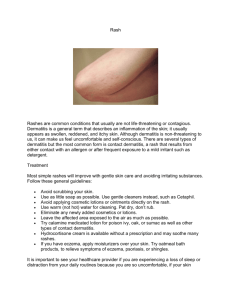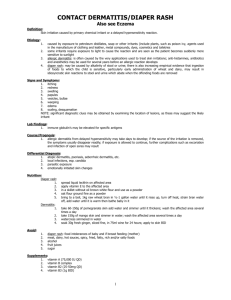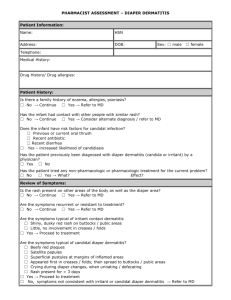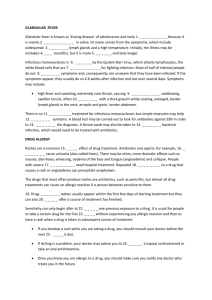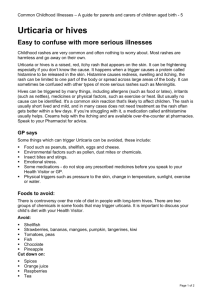Pediatric Charting - Funandeducation.org
advertisement
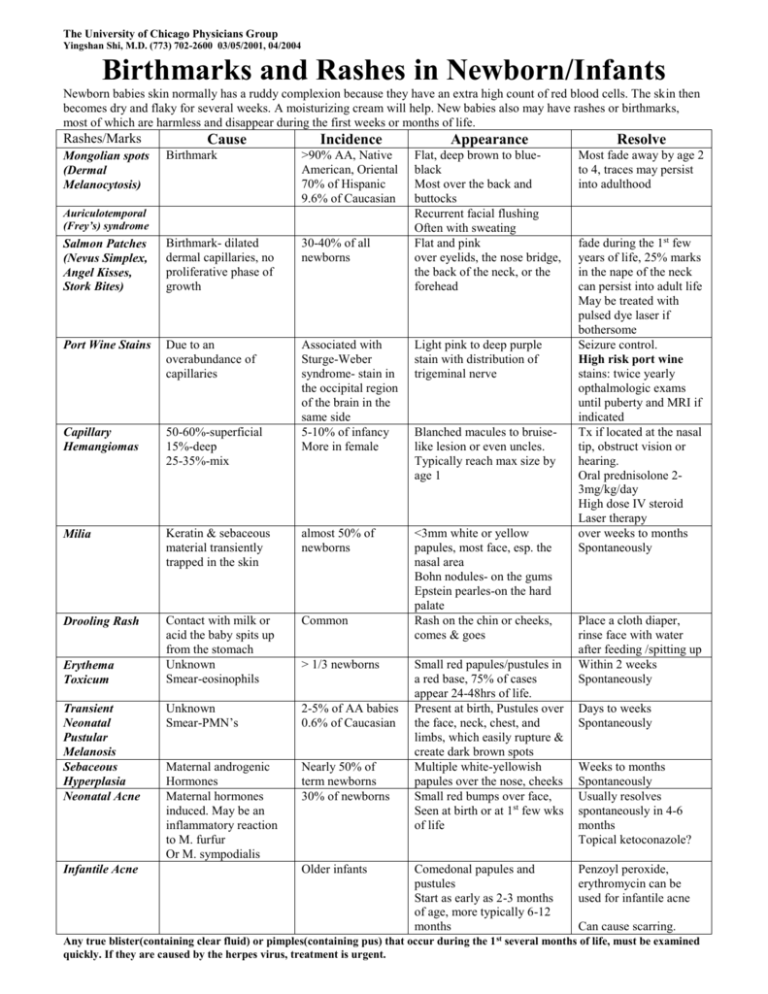
The University of Chicago Physicians Group Yingshan Shi, M.D. (773) 702-2600 03/05/2001, 04/2004 Birthmarks and Rashes in Newborn/Infants Newborn babies skin normally has a ruddy complexion because they have an extra high count of red blood cells. The skin then becomes dry and flaky for several weeks. A moisturizing cream will help. New babies also may have rashes or birthmarks, most of which are harmless and disappear during the first weeks or months of life. Rashes/Marks Incidence Appearance Resolve Birthmark >90% AA, Native American, Oriental 70% of Hispanic 9.6% of Caucasian Most fade away by age 2 to 4, traces may persist into adulthood Salmon Patches (Nevus Simplex, Angel Kisses, Stork Bites) Birthmark- dilated dermal capillaries, no proliferative phase of growth 30-40% of all newborns Flat, deep brown to blueblack Most over the back and buttocks Recurrent facial flushing Often with sweating Flat and pink over eyelids, the nose bridge, the back of the neck, or the forehead Port Wine Stains Due to an overabundance of capillaries Light pink to deep purple stain with distribution of trigeminal nerve Capillary Hemangiomas 50-60%-superficial 15%-deep 25-35%-mix Associated with Sturge-Weber syndrome- stain in the occipital region of the brain in the same side 5-10% of infancy More in female Milia Keratin & sebaceous material transiently trapped in the skin almost 50% of newborns Drooling Rash Contact with milk or acid the baby spits up from the stomach Unknown Smear-eosinophils Common <3mm white or yellow papules, most face, esp. the nasal area Bohn nodules- on the gums Epstein pearles-on the hard palate Rash on the chin or cheeks, comes & goes Unknown Smear-PMN’s 2-5% of AA babies 0.6% of Caucasian Maternal androgenic Hormones Maternal hormones induced. May be an inflammatory reaction to M. furfur Or M. sympodialis Nearly 50% of term newborns 30% of newborns Mongolian spots (Dermal Melanocytosis) Cause Auriculotemporal (Frey’s) syndrome Erythema Toxicum Transient Neonatal Pustular Melanosis Sebaceous Hyperplasia Neonatal Acne Infantile Acne > 1/3 newborns Older infants Blanched macules to bruiselike lesion or even uncles. Typically reach max size by age 1 Small red papules/pustules in a red base, 75% of cases appear 24-48hrs of life. Present at birth, Pustules over the face, neck, chest, and limbs, which easily rupture & create dark brown spots Multiple white-yellowish papules over the nose, cheeks Small red bumps over face, Seen at birth or at 1st few wks of life Comedonal papules and pustules Start as early as 2-3 months of age, more typically 6-12 months fade during the 1st few years of life, 25% marks in the nape of the neck can persist into adult life May be treated with pulsed dye laser if bothersome Seizure control. High risk port wine stains: twice yearly opthalmologic exams until puberty and MRI if indicated Tx if located at the nasal tip, obstruct vision or hearing. Oral prednisolone 23mg/kg/day High dose IV steroid Laser therapy over weeks to months Spontaneously Place a cloth diaper, rinse face with water after feeding /spitting up Within 2 weeks Spontaneously Days to weeks Spontaneously Weeks to months Spontaneously Usually resolves spontaneously in 4-6 months Topical ketoconazole? Penzoyl peroxide, erythromycin can be used for infantile acne Can cause scarring. Any true blister(containing clear fluid) or pimples(containing pus) that occur during the 1 st several months of life, must be examined quickly. If they are caused by the herpes virus, treatment is urgent. The University of Chicago Physicians Group Yingshan Shi, M.D. (773) 702-2600 03/05/2001, 04/2004 Birthmarks and Rashes in Newborn/Infants Continue Rashes/Marks Cause Incidence Appearance Seborrheic Dermatitis (cradle cap) Inflammatory eczematous dermatitis Cause is unknown Flaking and dryness, or red of the scalp, with greasy & yellow scaling Diaper Dermatitis Too much moisture Chafing or rubbing Irritant /urine, feces Yeast infection Bacterial infection Allergic reaction Psoriasis Histiocytosis > 50% babies Miliaria Rubra (Heat Rash) Miliaria Crystallina Heating, pressure & friction Sweat retention within the eccrine ducts. Many infants develop miliaria in the first weeks of life Very small (1-3mm) red vesicles or papulo-pustules Atopic Dermatitis (Eczema) Unknown Genetics 1 parent-60% chance 2 parents-80% Chromosome 11q linkage Onset 80% 1st year 90% by 5 years Infant-cheek, extensors Child-antecubital,popliteal Adult-face, neck, flexors Red skin Red rash Johnson-Johnson Desitin A&D Vaseline Triple Paste Dr. Smith Bal Dry, red rash, and itch Weeping, crusted, Thicken, lichenified Dark/light color 40-95% outgrow disease Acropustulosis of Infancy Unknown 1% of neonates More common in AA males Impetigo Bacteria infection Young children Warm, humid climate Poor hygiene Fungus (mold) infection After skin scraps, minor cuts or insect bites Tinea Corporis (Ringworm) Common Reddish, highly itch papules-pustular and vesicular lesions Appears hours after birth or up to 10 months Red sore with honey crust Circular lesions with red raised border, relative clear center. 1/2-1 inch Resolve Selenium shampoo Mineral oil & rinse .5-1% hydrocortisone 2% ketoconazole Change diapers often Clear water, less soap Pat/air dry, not rub A thick barrier layer oint. or cream No over-use of wipes No talcum or powder Consult with doctor if the rash persists 3 to 4 days Avoid hot & humid condition, dress in lightweight clothing, kept in a comfortable temperature Bath-1-2/daymild soap oil or oatmeal All cotton clothing Moisture-greasy baby Oint, no lotion/cream Aquaphor, Vaseline , Eucerine Cool temp environment Humidifier in winter Air conditioner/ summer Avoid pets/ smorkers Diet Breast feeding Soy/elemental formula Delay introduce solids Avoid common allergens Antihistamine for itch Steroid by physician Antibiotics- infection Can persist for 2-3y Topical corticosteroid (1% hydrocortisone) Antihistamine Clean with anti-bacterial soap Antibiotics-skin / oral Avoid spreading 1% Lotrimin twice/day (clotrimazole) Call Dr. if no resolving after 1wk of treatment The University of Chicago Physicians Group Yingshan Shi, M.D. (773) 702-2600 03/2002, 08/2004 Diaper Rashes in Newborn/Infants Rashes/Marks Irritant Contact Dermatitis Cause Too much moisture Changing or rubbing Irritant /urine, feces > 50% babies Yeast Infection (Candida) Yeast growing in the moist, warm skin surface Streptococcal Infection Bacterial infection Can associate with bloody stooling Seborrheic Dermatitis Psoriasis Pseudomiliaria Crystallina Allergic Contact Dermatitis Acrodermatitis Enteropathica (AEP) Langerhans' Cell (LCH) Type I Histiocytosis Red skin, Red rash Johnson-Johnson Desitin A&D Vaseline Triple Paste Dr. Smith Balmax Red rash in the crease area or as satellite distribution Involve intertriginous areas Culture Tx for irritant dermatitis Triple antibiotic ointment (over the counter) twice or three times a day May clear spontaneously by 2-3 months Anti-seborrheic shampoos Corticosteroids can make them last longer Usually go away after 2-3 months Rule out staphylococcal pustulosis Keep the child cooler AR disorder of zinc deficiency More common in the premature infants who are not breast fed. Child is often irritable and not feeding well. Rare. Severe multisystem disease may begin with a progressive diaper dermatitis. 1st few months of life Erosive diaper dermatitis, diarrhea, and hair loss The eruptions may also be around the mouth, knee, elbows, anus & fingers. Sometimes diaper rash & fever could be the earliest sign Change diapers often Clear water, less soap Pat/air dry, not rub A thick barrier layer oint. or cream No over-use of wipes No talcum or powder Consult with doctor if the rash persists 3-4 days Tx for irritant dermatitis Anti-yeast medication: 2% Nystatin ointment or 1% lotrimin cream (over the counter) twice or three times a day Anti-inflammation:1% Hydrocortisone cream if the skin is red Can leave a kaposi's sarcoma-like, granulomatous angioma Lichen Sclerosus & Atrophicus Resolve Erythematous, weeping; or scaly rash around the anus May become secondarily infected with Candida Unknown etiology Heat related Wear plastic covers over the diaper or infant kept too warm Less common Benign Histiocytosis Kawasaki Syndrome Appearance Small vesicles, sometimes on an erythematous base Seborrheic-like, salmon colored rash on the trunk. Can affect gum, fingernail or toenail Reddish-yellow patches and papules- most on the head and neck Occur in girls or boys. Perianal area Slight red, slight whitening or shiny appearance in parts Red, bullous rash Often in perineal area Sick & irritable child Usually resolved spontaneously within several yrs May not resolve until puberty. The University of Chicago Physicians Group Yingshan Shi, M.D. (773) 702-2600 01/28/2001 Birthmarks and Rashes in Newborn/Infants Rashes/Marks Cause Incidence Scaly Newborns Collodian Baby Ichthyoses Scaling disorders Congenital ichthyosiform erythroderma and lamellar ichthyosis Ichthyosis vulgaris and Xlinked ichthyosis Vesiculopustular Dermatoses Infections Herpes Simplex Both are autosomal recessive Varicella Congenital syphilis Diagnosis Treatment Normal desquamation/peeling begins at 24-36 hours of age and complete for several weeks. Desquamation at birth or during the 1st day of life suggests post-maturity, intrauterine stress, or congenital ichthyosis Encased in a thick, cellophane like membrane, may desquamate to leave normal skin- usually complete by 2-3wks 60-70% develop congenital ichthyosiform erythroderma Appear normal at birth, within minutes, develop a thick, generalized membrane, deep cracks and fissures. Most infant succumb to respiratory distress or infection Collodian membrane at birth. 1/3,500 deliveries 30% of MR if appear during the 1st week of life High risk for hypernatremia, dehydration , Hyperpyrexia and infection Risk factors Premature Use of prenatal steroids Maternal vulvovaginitis Generalized erythmatous maules, papules and pustules, versicles and bullae Can with desquamation, erosion, and burnlike erythema Affect palms and soles, diaper area is often spared Onset < age 2 Rash, rhinorrhea, periostitis, FFT hepatosplenomegaly Vesiculobullous Eruptions Mechanobullous Epidermolysis Blistering dermatoses Diseases Bullosa (EB) Aplasia Cutis Congenita Mastocytosis Congenital erosive and vesicular dermatosis with supple reticulated scarring Incontinenetia pigmenti Resolve High humidity, neutrally thermal environment. Petrolatum emollient Not develop scaling until 3 month of age or later Impetigo and Staphylociccal Scalded –Skin Syndrome Disseminated Congenital Candidiasis Appearance Fluids, electrolyte, bland emollients
